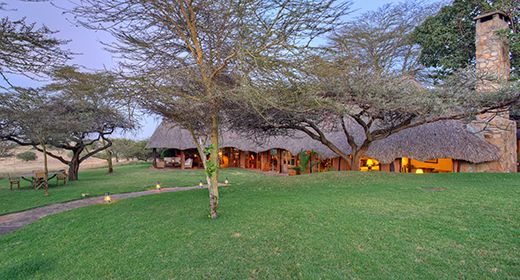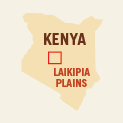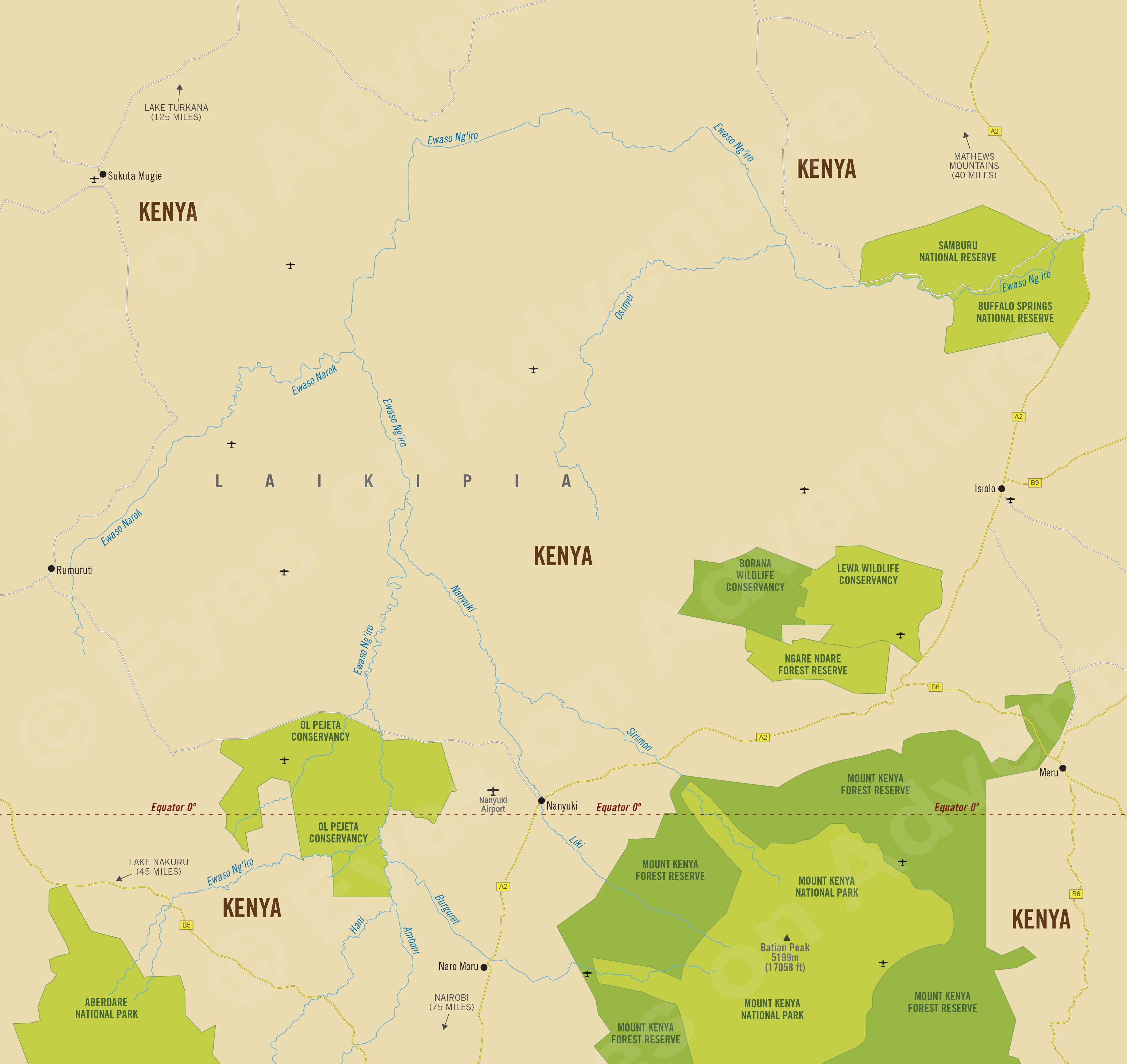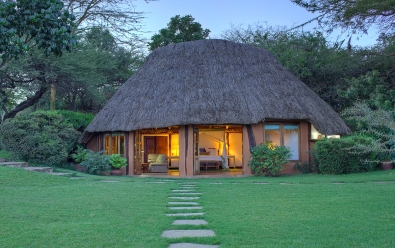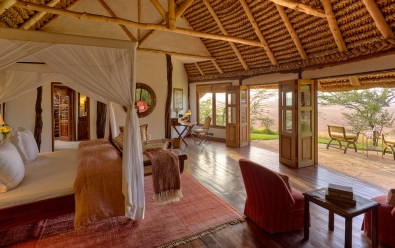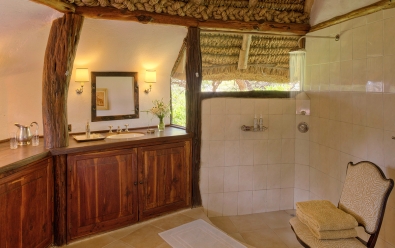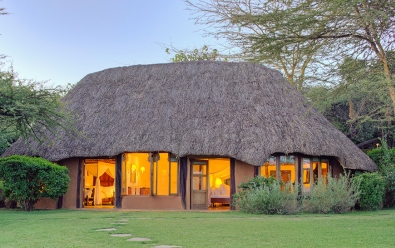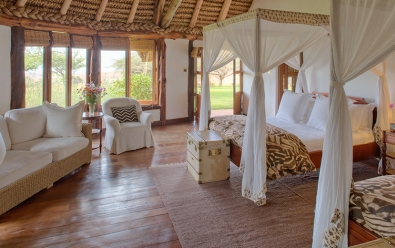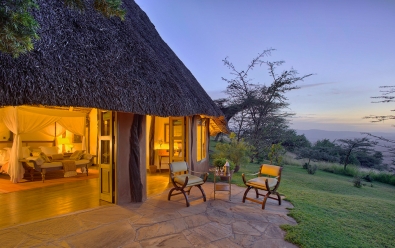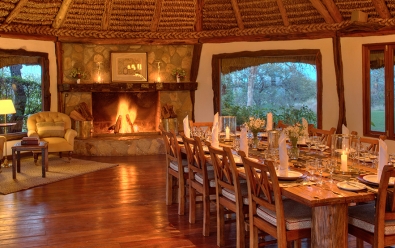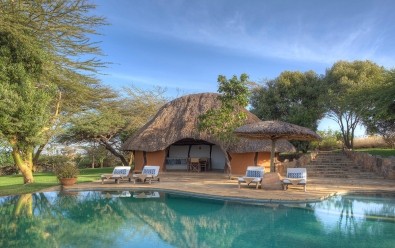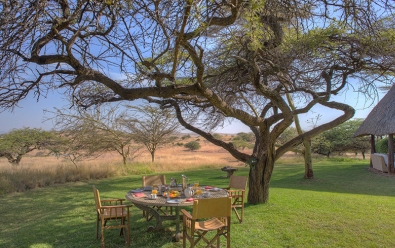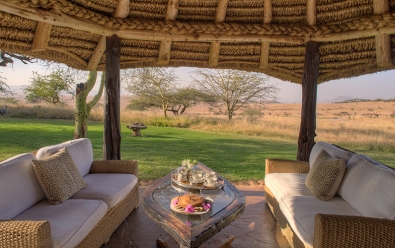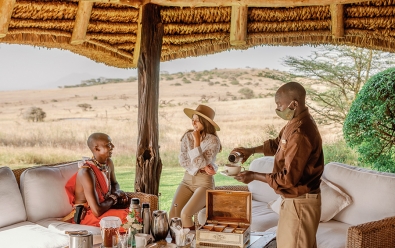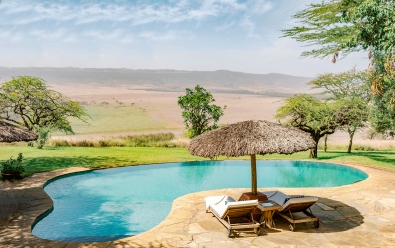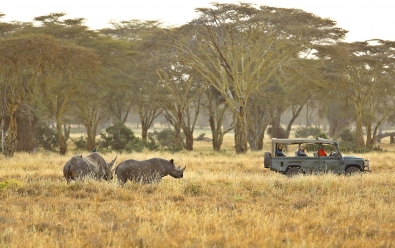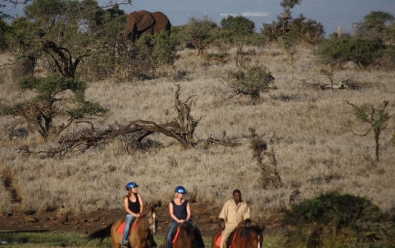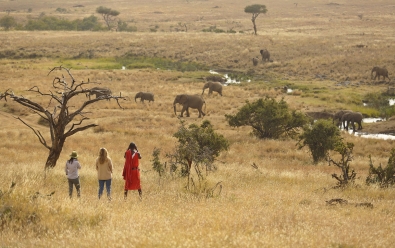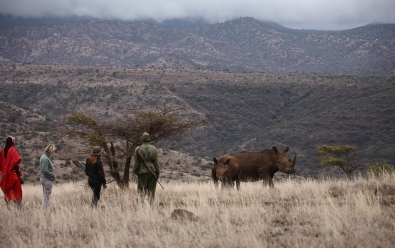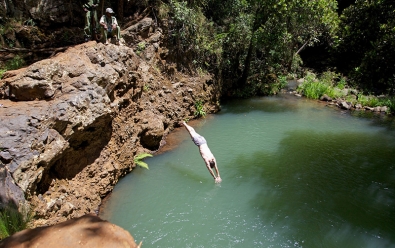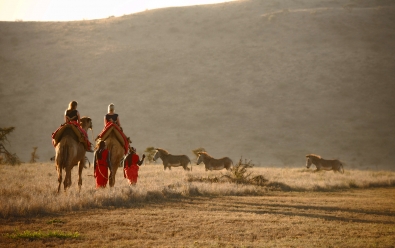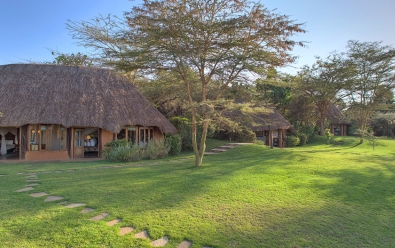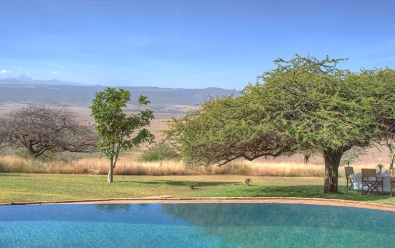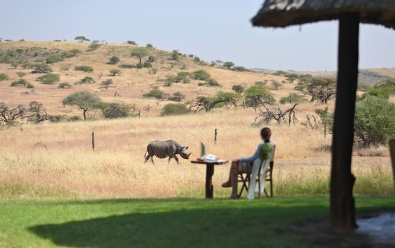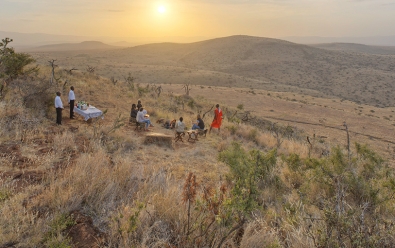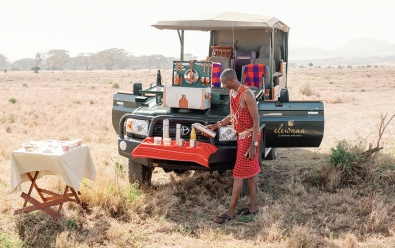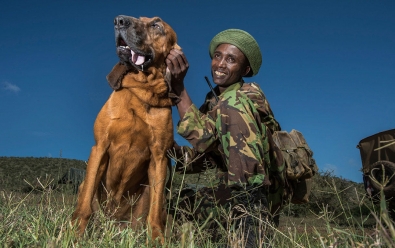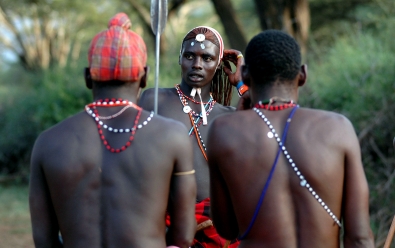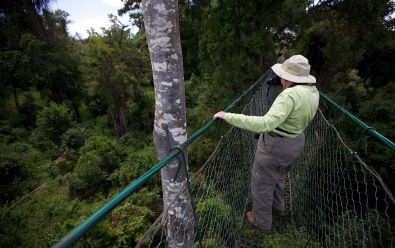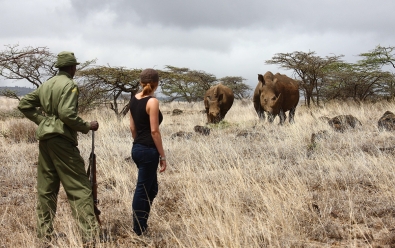Kifaru House
Location
- Lewa Wildlife Conservancy
- Southeast Laikipia Region
- Central Kenya
Kifaru House is located in the Lewa Wildlife Conservancy, which is one of the best wildlife destinations in Kenya and part of an UNESCO World Heritage Site.
Lewa is one of the most respected privately-managed conservancies in Africa and home to around 100 black rhinos and 100 white rhinos. The reserve also has the largest single population of the endangered and beautiful Grevy's zebra and around 200 endangered reticulated giraffe. Read all about the Lewa Conservancy below.
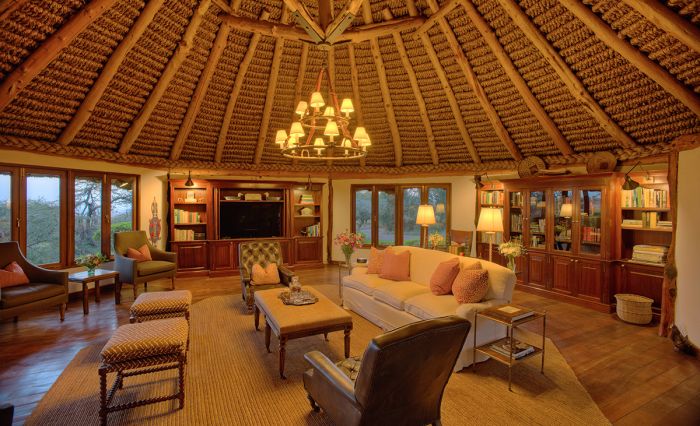
Main house lounge at Kifaru.
This small and intimate property is situated atop a hill with spectacular views towards Mount Kenya in the south and the arid lowlands to the north. The main house and cottages are surrounded by lovely fever trees, vibrant lawns, and floral gardens that attract abundant bird life. A vegetable garden supplies the camp with home-grown produce.
Activities offered include include game drives to see the abundant and diverse wildlife, guided walks to see rhinos and other wildlife, horse riding, camel riding, and visits to the Lewa Headquarters to learn more about the reserve's operation and see their anti-poaching team and sniffer dogs.
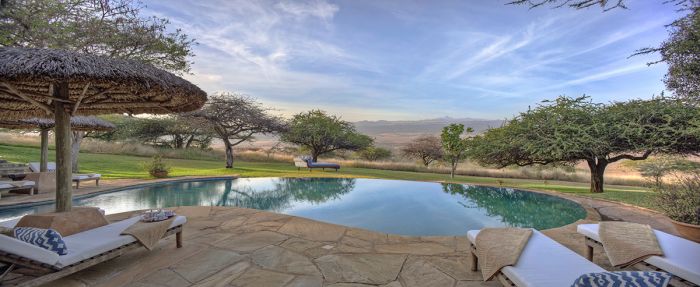
Kifaru House swimming pool and view.
Additional activities outside the conservancy include day trips to the Ngare Ndare Forest, where one can hike, try the canopy walk, and swim in clear-water springs. Cultural visits to a local community and school are also on offer.
The property offers just five charming guest cottages with elegant four-poster beds, antique-style furniture, and spacious en-suite bathrooms. One of the cottages has two-bedrooms and is designed especially for families. Children of any age are welcome and children's activities and menus are available.
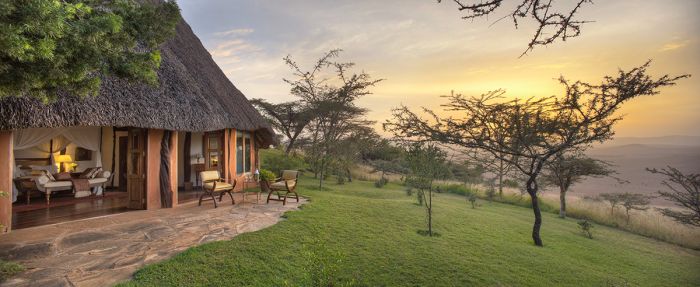
Guest cottage and view over the conservancy from Kifaru House.
About Laikipia
Laikipia is a middle-altitude plateau that lies northwest from the central Highlands of Kenya and covers over 3 700 square miles (9 500 sq kms). The region is a transitional zone between the lush and mountainous highlands of Mount Kenya and the Aberdare Mountains to the southeast, the Rift Valley to the south and west, and the arid, semi-desert Samburu region to the north. The plateau ranges in elevation from 5 600-8 300 feet (1 700-2 550 meters).
The Laikipia region has historically been used by humans for cattle ranching going back to the colonial era and there is still ranching in Laikipia. There are no national parks or reserves in Laikipia; instead, there is an assortment of private conservancies and group-ranches which together protect land and wildlife even to a higher degree than Kenya's national parks and offer some of the best wildlife experiences in the country.
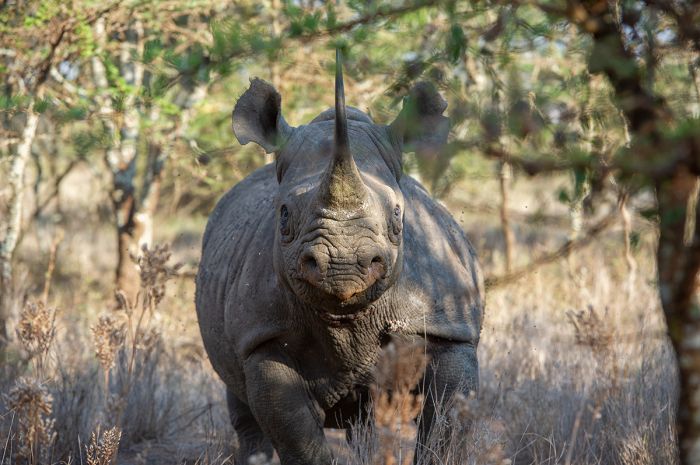
Black rhino at Lewa Conservancy (Copyright © James Weis).
The private and community-managed conservancies in Laikipia mostly operate as dual-use properties, with eco-tourism, research, and conservation co-existing with livestock ranching. Some of the original colonial ranches in Laikipia now operate as safari lodges, while still maintaining their ranching operations. In addition to traditional safari drives to look for wildlife, these ranches usually offer guests an opportunity to experience ranching activities and horseback riding.
Wildlife in Laikipia is diverse and abundant, particularly within the refuges, including Lewa, Ol Pejeta, and Borana. Animals that can be seen include healthy populations of plains species like black rhino, white rhino, elephant, reticulated giraffe, Grevy's zebra, plains zebra, buffalo, Grant's gazelle, Thomson's gazelle, Jackson's hartebeest, and others.
Laikipia's predators include cheetah, lion, leopard, African wild dog, black-backed jackal, and other small species.
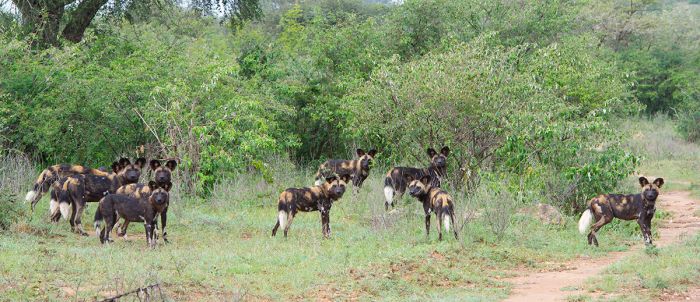
African wild dogs in Central Laikipia (Copyright © James Weis).
The Laikipia Wildlife Foundation (LWF), a non-profit organization formed in 1992, oversees the region as a whole. Membership in LWF includes all private ranches and conservancies in Laikipia, as well as the community groups representing the diverse local tribes such as the Maasai, Kikuyu, Samburu, and Pokot.
The three main wildlife conservancies in Laikipia are Lewa, Borana and Ol Pejeta. All are located in central or southern Laikipia and each offers a superb safari experience and excellent accommodation. Visitors are able to see the diverse wildlife and learn about the conservation initiatives at each of the reserves
Northern Laikipia is remote and wild and the land becomes more arid. The ranches in the north offer a diversity of activities, from camel riding, mountain biking, hot-air balloon rides, rafting on the Ewaso Ng'iro River, walking safaris, and nature drives. Wildlife in the north is more sparse, but the experience of being in this wilderness is special. Ranches in the north include Loisaba, Mugie, Ol Lentil, Ol Malo, and others.
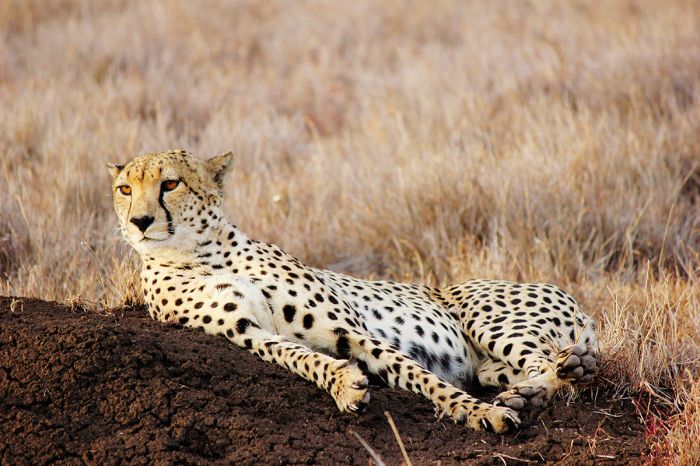
Cheetah in the Lewa Conservancy.
About Lewa
The Lewa Wildlife Conservancy, which covers 96 square miles (250 sq kms), is a non-profit wildlife conservation refuge originally formed in 1983 as the Ngare Sergoi Rhino Sanctuary. The sanctuary was established to save the last of northern Kenya's critically endangered black rhinos. Ngare Sergoi became the Lewa Wildlife Sanctuary in 1995.
Before it became a protected sanctuary, the land was a cattle ranch, but today Lewa is one of Laikipia's finest reserves. The conservancy is completely fenced and very well managed. Lewa's mission is to work closely with the surrounding communities to ensure that they, as well as the wildlife, benefit from its conservation efforts. Lewa is a member of the Northern Ranglelands Trust, which includes local communities as its partners.
Lewa, together with the Borana Conservancy, which lies directly to the west, protect around 14% of Kenya's rhino population and 11% of its remaining Grevy's zebras. The combined reserves are one of only three reserves which have a stable and increasing black rhino population.
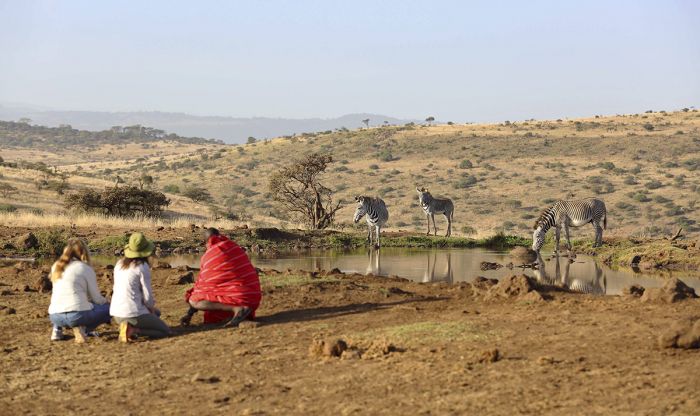
Guided walk in Lewa and Grevy's zebras at a waterhole.
Lewa is primarily grassland with interspersed hills, scrub bush, and wooded valleys, providing excellent habitat for its healthy populations of both black and white rhino. Lewa is also home to around 350 Grevy's zebra, the largest single population of this species in the world. The Lewa swamp boasts a localized population of sitatunga antelope, originally relocated from the Saiwa swampland during the 1980's.
In addition to the endangered species protected at Lewa, the general game viewing is excellent, with all of Africa's Big Five found here. Elephants are found in good numbers, as well as reticulated giraffe, buffalo, blue wildebeest, Beisa oryx, eland, impala, Grant's gazelle, and gerenuk.
Lewa also boasts a host of predators including lion, leopard, cheetah, spotted hyena, black-backed jackal, and sometimes African wild dog. Hippos are found in the Lewa swamp.
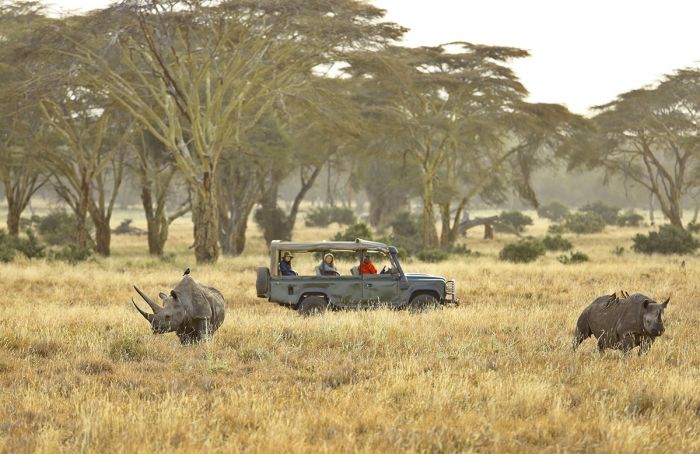
Black rhinos seen on a game drive in Lewa.
ROOMS INCLUDES & EXCLUDES CHILDREN FACILITIES ACTIVITIES
Accommodation
5 guest accommodations in total comprising:
- 4 cottages, each with a king-size bed.
- 1 two-bedroom family cottage. One of the bedrooms has a king-size bed and the other has two twin beds. Each bedroom has its own entrance and the rooms are not interconnecting.
The cottages are constructed using earthen clay and wood beams. The ceilings are vaulted and made from woven sisal and the flooring is hardwood. The outer roofs are thatched. The en-suite facilities include a single-basin vanity, indoor shower, and flush toilet. One of the cottages has a bathtub and an outdoor shower enclosed by reed thatching.
The cottages are accessed via footpaths on the ground leading to the main lodge area.
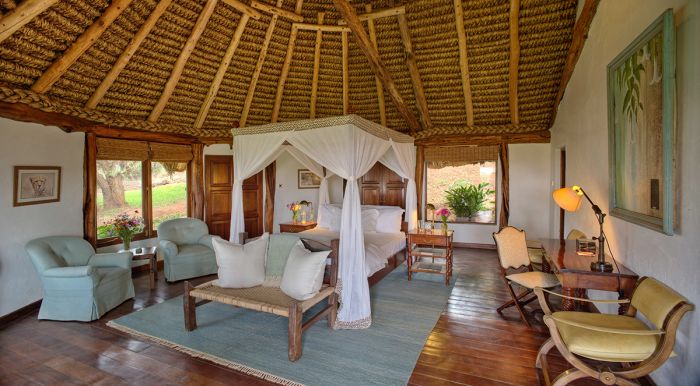
Guest cottage interior at Kifaru House.
Each cottage has a stone, outdoor veranda in the rear with outdoor seating offering magnificent views of the conservancy from the elevated position atop a hill. The verandas are accessed from the bedroom via wide, wood-and-glass folding doors that will allow in the evening breeze.
The cottages include charming four-poster beds, comfortable antique-style furniture and fixtures, and elegant throw rugs.
Other items and features in the guest tents include:
- Outdoor veranda.
- Writing desk and chair.
- Comfortable lounge chairs.
- Mosquito netting over the beds.
- Hairdryer.
- Bathrobes.
- Safe.
- 24-hour electric power for lighting and charging electronics.
- The camp's solar power cannot support hairdryers. A hairdryer is available for in the reception area.
- Wi-Fi available in the guest cottages and main guest areas.
- Mobile phone signal available, but limited.
Kifaru House can accommodate a maximum of 12 guests in total: 2 persons in each of the 4 standard cottages and 4 persons in the family cottage.
Includes & Excludes
Includes:
- All meals and local beverages including soft drinks, house wines, local brand spirits and beers, teas, and coffees.
- Safari experiences (twice-daily game drives, walking safaris, visits to the wildlife-viewing hide, and birding) accompanied by an experienced guide.
- Exclusive use of a safari vehicle when booking the family cottage.
- Sundowners and bush breakfasts.
- Laundry services are provided on a daily basis (weather permitting, items will be returned on the same day). Laundry is dried by the sun and on most days any laundry placed out in the morning will be returned by the evening.
- Wi-Fi access (in the main house and guest cottages).
- Lewa Airstrip transfers.
- Tourism Levy & VAT.
Excludes:
- Champagne, cognacs, fine wines, and premium brand spirits.
- Horse riding.
- Camel-riding.
- Visits to the Lewa Conservancy HQ to learn about the running of the conservancy.
- Visiting the Anti-Poaching Tracker Dogs.
- Visits to a community village and school.
- Day trips to Ngare Ndare Forest, where you can swim in the clear blue waters of the springs, walk the canopy bridge through the forest, and enjoy a picnic lunch.
- Any applicable wildlife fee, park fee, reserve fee, concession fee, other land-use fee.
Single Supplement
A single supplement may apply for any room booked by a single traveler; please ask us for pricing.
Children
Children of any age are accommodated at Kifaru House:
- Family cottage available.
- Ask us about reduced rates for children sharing with adults or children 12-17 in their own cottage.
- Child-friendly activities are offered.
- Children's menu available.
Some of the children's activities include:
- Heated swimming pool
- Guided house grounds “bush” walk - short walk looking at the trees, flowers, grasses, insects, birds and bird calls, mammals, tracks, and droppings.
- Visit to Lewa HQ to see the sniffer dogs (extra cost).
- School visit - normal term times (extra cost).
- Horse riding for older experienced riders (extra cost).
- Camel riding for older children (extra cost).
Facilities
The camp is located atop a hill with spectacular views towards Mount Kenya in the south and the arid lowlands to the north. The main house and cottages are surrounded by lovely fever trees, vibrant lawns, and gardens that attract abundant bird life. There is a heated swimming pool with shaded loungers and a pool house for relaxing between activities.
Main guest area facilities include:
- A main house comprising a lounge with fireplace, dining room, and bar.
- A library (separate structure located adjacent to the main house).
- Large, heated swimming pool, sun deck, and pool house.
- Vegetable and flower gardens.
- Helipad.
- Complimentary Wi-Fi access.
- Electronics charging facilities.
- Mineral water is provided from dispenser points in the main camp areas. Mineral water provided during meals and in guest tents. Guests are issued with a refillable bottle.
- The camp is 100% powered using solar energy, but a generator is available for backup on cloudy day, which gives 24-hour electricity to the guest areas and cottages.
Activities
Activities included in the rate:
- Morning and afternoon/evening game drives in the conservancy using open 4x4 vehicles.
- Guided bush walks. Children under 16 years of age may be restricted. All bush walks are subject to the discretion of the lead guide due to the nature of the activity.
- Visits to the wildlife-viewing hide.
- Bush breakfasts and sundowners.
- Birding.
- Child-friendly activities.
- All game drive vehicles are fitted with inverters for battery charging on game drives.
Optional activities at additional cost:
- Private activities are on offer (subject to vehicle availability, which needs to be booked in advance).
- Horse riding.
- Camel-riding.
- Visits to the Lewa Conservancy HQ to learn about the running of the conservancy.
- Visiting the Anti-Poaching Tracker Dogs.
- Visits to a community village and school.
- Day trips to Ngare Ndare Forest, where you can swim in the clear blue waters of the springs, walk the canopy bridge through the forest, and enjoy a picnic lunch.
- Massages, manicures, and pedicures.
Example of a typical day:
- Early morning wake-up call. Morning wake-up and activity times vary according to the seasons, activities on offer, and wildlife sightings.
- Light breakfast before departing on the morning activity or food packed for a bush breakfast.
- Return to the house for a meal and rest period.
- Meet for afternoon tea and snacks (savory and sweet choices) before departing on the activity.
- Return to the house - freshen up or meet for drinks, followed by dinner.
- Enjoy a nightcap and/or discussion at the bar or around the fireplace before retiring.
Great Good Fair Poor
- Jan
- Feb
- Mar
- Apr
- May
- Jun
- Jul
- Aug
- Sep
- Oct
- Nov
- Dec
When to Visit
Laikipia is generally a year-round destination, but the best time to visit is during the relatively dry season from June thru September. As with most of Kenya, the short rains on the Laikipia Plateau occur for about a month sometime between mid-October and mid-December. The longer and heavier rains occur from March thru May.
No period is completely without rain, but the wettest months are April, May, and November and the driest months are January, February, and September.
Temperatures are also fairly constant year-round, as the equator is located very close (just to the south). Temperatures during the day average 77-83°F (25-28°C), but to cools down quite a bit overnight and dressing in layers is a must for the morning activity.
Kifaru House is open year-round. Minimum 2-night stay.
Winter
June through September are the winter month and relatively dry, but rain is still quite possible. June and July experience static temperatures, averaging 77-79°F (25-26°C) during the day and dropping to around 48-50°F (9-10°C) overnight.
Temperatures increase slightly in August and September, averaging 80-82°F (26-28°C) during the day and 50-52°F (10-11°C) during the night. Some rains do fall in August and September.
Most days during the winter are clear to partly cloudy.
Summer
The runner months are October through May, which includes the short rains, which fall for about a month between October and December and the longer, heavier rains from March through May. April is the rainiest month.
October and November experience daytime temperatures averaging 74-76°F (23-24°C) and overnight lows of 54-55°F (12-13°C).
Mid-December through February is a period of low rainfall, which separates the previous short rains from the coming long rains. There are still some days with rain. Daytime temperatures reach 76-79°F (24-26°C) and overnight lows are 52-54°F (11-12°C). Days can be clear or overcast.
March through May are the long rain months, with April being the rainiest month. This is a period to avoid, as the rains can be heavy and persistent, although all-day rains are uncommon. The road conditions can become muddy and slippery. Daytime temperatures average 78-81°F (25-27°C) and overnights average a comfortable 54-55°F (12-13°C).




